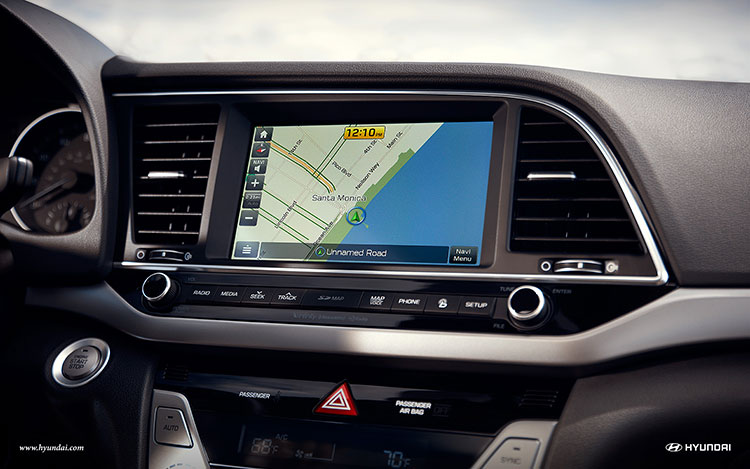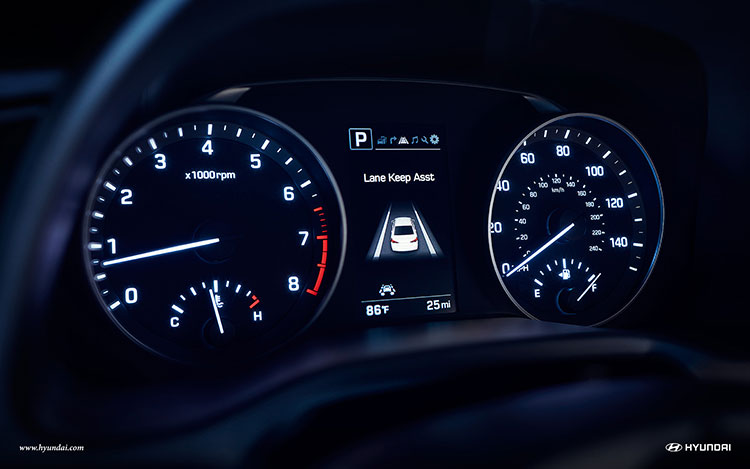Tom's Guide Verdict
The 2017 Hyundai Elantra combines CarPlay, Android Auto and a robust set of safety features in a sleeker and quieter ride.
Pros
- +
Apple CarPlay and Android Auto support
- +
Blue Link subscription offers remote start and other useful features
- +
Premium Clari-Fi sound system
- +
Active lane assist works well
- +
Quieter ride than previous Elantras
Cons
- -
Blind-spot warnings are a bit too subtle
- -
Limited voice commands
- -
Adaptive cruise control doesn't work below 6 mph
Why you can trust Tom's Guide
It's axiomatic that a technology is successful when it becomes commonplace. With its 2017 Elantra, Hyundai is hoping to prove this is the case by offering safety and driver assistance technologies usually reserved for the luxury class.
The Elantra has been redesigned for this model year, with a lengthy list of available technology options that includes not just connected smartphone support for Apple's CarPlay and Google's Android Auto, but also automatic emergency braking, lane departure warnings and lane keeping assist, turning headlights, a rearview camera, and rear cross traffic alerts. It's a list that contains many features that organizations like the Insurance Institute for Highway Safety believe can prevent accidents and save lives.
With such advanced safety technologies in a mainstream consumer sedan, the Elantra also makes for a more relaxing commuting vehicle. However, shoppers should note that the inclusion of all of the options (which I recommend) will significantly raise the price of the car. The base model 2017 Elantra starts at $17,150, but when you add all of the technology options — and a higher trim level — the price goes up to $26,750. (My test vehicle was $27,710.) Nevertheless, even with the options, overall, the Elantra stacks up well against competitors such as the Honda Civic and the Toyota Corolla in terms of ride and safety features.
2017 Hyundai Elantra: The Vitals
Price as Tested: $27,710 MSRP
Engine and Drive Train: 2.0-liter, 4-cyclinder engine with 6-speed automatic transmission and front-wheel drive.
Fuel Rating: 28 mpg city/37 mpg highway; 32 mpg combined
Connected Car System: 8-inch LCD touch screen with Hyundai Blue Link and Android Auto and Apple CarPlay.
Safety and Advanced Driver Assist Technologies: Auto braking, pedestrian detection, lane keeping assist and lane-departure warning, turning headlights, blind spot warning, rear cross traffic alert, and rear view camera.
In-Car Tech
On the connectivity side, Hyundai has gone out of its way to support Apple's CarPlay and Android Auto. Both systems worked well, within the apps’ inherent limitations and the required connectivity. On my test drive into the hills far from San Diego, there were spots where there was no cell service, which concomitantly cut off CarPlay services (except for playing music already stored on the phone).
Pandora gets its own separate icon directly on the Hyundai screen, so if all you want to do is stream your favorite custom stations, you don't have to bother with CarPlay or Android Auto. For further smartphone support, there are two USB ports for charging.

Fortunately, the Ultimate package on the Elantra includes its own built-in navigation system. (No, you cannot run both navs simultaneously.) I found its instructions clear and concise, including the on-screen prompts. Its directions were generally spot-on, save for a shortcut that spit us out onto a washed-out backcountry dirt road that probably shouldn't even be a part of the system's maps.
Get instant access to breaking news, the hottest reviews, great deals and helpful tips.
The nav system responded well to spoken commands but understood a very limited lexicon. Translation: You cannot use voice commands to change radio stations or set the heating or AC. Similarly, Android Auto and CarPlay don't have access to these systems, so you can't use Google Voice or Siri for those functions.

Hyundai offers its own Blue Link connected service free for the first year, and then starts at $99 annually for a basic subscription. Blue Link, which also works with Android and iOS devices, delivers a solid set of OnStar-like services, including remote start, geofencing, and remote speed and curfew alerts (something parents will appreciate). The Blue Link subscription is also required if you want to use these features on an Android Wear-compatible watch or Apple Watch.
MORE: Apple CarPlay vs. Android Auto: Connected Car Face-Off!
One interesting addition is a premium sound system from Harman under the Infinity brand. It includes eight speakers and an active acoustic algorithm that tries to improve the quality of compressed sound. It's called Clari-Fi and is primarily an attempt to put back dynamic range and frequencies stripped out of music in MP3 tracks and streaming services like Pandora. Digital tracks by Steely Dan definitely sounded less steely on the Infinity sound system, but my impression was that mainly, the midrange was boosted by Clari-Fi, making for what most listeners will find to be a more pleasing, rounded sound. However, you cannot shut off Clari-Fi if you don't like it.
Safety Tech
With the Ultimate package for the Limited edition of the Elantra comes a welter of driving tech. Up front are what Hyundai calls bending lights, which means that the headlights turn on a mechanical mount as you turn the wheel so that you always see what's directly ahead. It's a feature that I have appreciated in other cars, especially on cloverleafs at night (although I was unable to test this feature on the Elantra).
A radar sensor in the grille and a camera in the windshield behind the mirror combine to support several safety features. There's the pedestrian warning and collision avoidance system, for example. It's strictly tuned to look for bipeds. It won't jam on the brakes for Fido, and it did not alert me to the occasional cyclist in my path on narrow roads in the Southern California hills. On the other hand, the lane departure warning system would ping me every time I swerved around the cyclists without signaling.

Blind-spot warnings in the Elantra's side mirrors were also helpful but perhaps too subtle at times. Larger lights in the sides would help (although some drivers might find that distracting).
Surprisingly, one of my favorite tech additions was the Elantra's active lane assist feature. It can be set to act as a mere lane departure warning system, delivering an alert bell every time you hug the white line too closely. Or, it can be set to actively steer the car back into the center of the lane when you wander. I experimented with the different modes and actually like Hyundai's implementation of the steering correction technology. In its most active mode, the wheel will pull you away from the double yellow line with a little tug of the wheel. It's not subtle, but it's also not too aggressive, nor does it produce irritating vibrations that some other systems rely on. One caveat: It's not sufficient for hands-free driving. This is not a semi-autonomous system.
One of my favorite tech additions is the Elantra's active lane assist feature, which can steer the car back into the center of the lane when you wander.
The 2017 Elantra also has smart cruise control as part of the Ultimate package. Like most adaptive cruise control systems, it will slow and accelerate to match the speed of a car ahead of you. However, it has one important weakness: It disengages at 6 mph or slower. In other words, it will not automatically stop and start in stop-and-go traffic. (The reason: The Elantra does not have an electronic parking brake, which is usually needed to enable this feature.)
The Drive
The new Elantra is more aerodynamic, and about 1 inch wider, than last year's model. It's also more attractive and less bug-eyed than earlier editions. More important, Hyundai has deployed a variety of technologies in an effort to reduce road noise, including using more adhesives (rather than spot welds), thicker door glass and a more rigid chassis. It seems to have worked, delivering a quieter, well-tempered ride.
The Elantra's rear suspension has been revamped to give it more flexibility and prevent the kind of dead rear-end feel that many front-wheel designs suffer from. It never skipped around on me, although I didn't push the car hard enough on, say, a washboard dirt road to seriously test it (although our one brief off-road excursion didn't seem to unsettle the car).

The 2017 model also has three driving modes — another feature once available only in luxury cars. A push of a button cycles you through an Eco mode for treehuggers, a Normal mode for relaxed city driving, and a Sport mode.
Sport mode noticeably tightens up the steering response. It made easy work of quick switchbacks, and it never made me feel like I was out of control even when I pushed too hard into an unexpected corner on a twisty canyon road. Leave it in Sport mode for quotidian commutes, however, and you'll find it takes extra effort to turn a corner at low speeds in traffic. Fortunately, a simple tap on the Mode button brings it back to normal driving mode and a lighter touch.
MORE: Connected Cars: A Guide to New Vehicle Technology
The Elantra was quick enough off the mark for an economy car, meaning it won't scare you with balky performance when you try to merge onto a highway. On the other hand, it's not exactly what I would call peppy. A forthcoming seven-speed turbo model may change that impression later this year.
Overall, the driving experience is comfortable and predictable. There were two features, however, that I was less than sanguine about. First, the Elantra is front-wheel-drive only; there is no all-wheel-drive option for those in snowy climates — although that's also the case with comparably priced competitors. Second, as with so many models in this price range that try to save fuel, the Elantra does not have a full-size spare tire; there's a compact temporary spare for emergencies.
Bottom Line
Fully loaded with the technology that I believe everyone should have, the 2017 Elantra is more than $26,000. Yet, that's certainly competitive with anything Toyota or Honda offers in this class, and arguably better. All in, the fully tricked-out Elantra should sound a note of optimism that what I consider to be essential accident prevention features are finally going mainstream (not to mention, the connected smartphone support). The question is, will Hyundai be able to convince price-sensitive buyers to opt for the full technology package?
John R. Quain has been reviewing and testing video and audio equipment for more than 20 years. For Tom's Guide, he has reviewed televisions, HDTV antennas, electric bikes, electric cars, as well as other outdoor equipment. He is currently a contributor to The New York Times and the CBS News television program.


